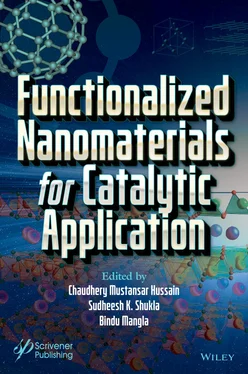1 ...7 8 9 11 12 13 ...18 In a separate work, Jiang, Z. et al . engineered TiO 2/g-C 3N 4by solvothermal method and proved its photocatalytic degrading properties over Rh B, MB, and CIP. H +and superoxide ·O 2−had significant role over ·OH radical in this reaction. Excitonic PL signals indicated that n-π* electronic shifts were involved by lone pairs e −present in N atoms of g-C 3N 4. Hetero yolk-shell structure formed significantly promoted the charge transference efficacy [166]. In a new protocol, facile magnetic g-C 3N 4/Fe 3O 4/p-Ru NP FNMs photo-nano catalyst got by deposition-precipitation process showed excellent degradation capacity and reusability with only 5% efficacy lost detected after five cycles. Photocatalysts degraded organic matters—aromatic amines and coloring pigments—azo dyes (CR, CB, EB, and RR-120) efficiently from industrial aqueous water. Formation of photo-electron creates h +(holes), where the reactive ·OH formed induces a responsible oxidative photo-degradation and h +(holes)/ ·O 2−radicals have insignificant roles [167].
1.5.1.5 Graphene-Carbon Nitride/QD-Based FNMs
Hydrothermally synthesized BWO fixed as ultrathin Bi 2WO 6NSs embedded on g-C 3N 4QDs as (CNQDs/BWO), belonging to Z-scheme, efficiently degraded organic contaminants of antibiotic TC and dye Rh B, with % efficacy of 92.51 and 87 in NIR and visible regions, in ~1 h. Langmuir-Hinshelwood model adopted by the authors Zhang, M. et al . later showed that the bandgap energy of 2.70 eV (BWO) and 2.60 eV (CNQDs) was sufficient to bring the change [168]. The authors Zhou, L. et al ., proved that GCNQD-treasured on modified g-C 3N 4had a worthy photocatalytic degrading activity against organic Rh B [169]. The experimentalists Lin, X. et al . observed that hydrothermally synthesized nano-heterostructures of CNQDs/InVO 4/BiVO 4on a leaf-like material of InVO 4/BiVO 4had ·O 2−radical as the main force behind the efficient oxidative-degradation of Rh B organic dye [170].
Similarly, heterostructure GCNQDs/Ag/Bi 2MoO 6NSs had a very good 100% degrading capability of Rh B in visible region, where h +of VB (Bi 2MoO 6) and e −of CB (CNQDs) worked effectively for oxidation/reduction to cause degrading reaction to give H 2O and CO 2[171]. Si NWs (silicon nano-wires) on g-C 3N 4QDs as Si NWs @ g-CNQDs, photoelectrocatalytically could decompose 85.1% of 4-CP in ~ 2 h from aqueous solution, had a notable charge separation and good stability [172]. π-conjugated GCNQDs implanted on metalloid sulfide Sb 2S 3/supported by ultrathin-g-C 3N 4, with a bandgap of 2.7 eV, were proved to be good candidate for photocatalytic disposals of MO from unwanted water and had a very good electron (e −) transference [173]. In a novel approach, the co-workers Patel, J. et al . synthesized Mn:ZnS/QDs, for photo-degrading fluoroquinolone: Norfloxacin in an ambient condition of solar-light/UV-light, where Mn and ·OH fortified the reaction to 4 reapplied cycles [174].
1.5.2 Polymer Composite–Based FNMs as Photocatalysts
Polymer TiO 2/CS/glass FNMs were powerful in decomposing RR4 organic dye in visible region. h +and ·OH generated from TiO 2layer circulate to TiO 2/CS boundary to cause oxidation of RR4. A total of 100% efficiency was noticed with the stability up to seven reusable cycles [175]. CdS/TiO 2-PAN FNM degraded MB (66.29%) in 210 min [176]. Researchers studied the photocatalytic action and inferred a repeated utility to protect the water system. Chitosan-AgCl/Ag/TiO 2synthesized by the team Jbeli, A. et al . was reported to be cost-effective photocatalytic degrader of organic components ABA, O-TD, and SA under visible radiations [177]. Similarly, surface modified FNM TiO 2/ZnO/chitosan had a powerful photo-degradability of MO (97%) when excited by solar radiations [178]. An organic/inorganic FNM as composites P3HT/PNP-Au NP got by re-precipitation method showed positive spectral line in UV region (~427 nm), had an enhanced photocatalytic decomposition of MB (90.6%), and inferred that it may be due to a strong π-π* shift [179]. A 3D honey-comb like ordered macro-porous NM-3DOM Ag/ZrO 2had significant photocatalytic degradability over CR when stimulated by multi-modules of microwave-assisted, simulated-solar, UV, and visible radiation [180].
1.5.3 Metal/Metal Oxide-Based FNMs as Photocatalysts
Metal/Metal oxide when entrapped as FNMs, on photo-irradiation leads to photo-excitation of particles that undergoes transference between the CB and VB, where the CB transfers the e −to degrade the pollutant [181]. Components like (1) semiconductor, (2) metal, and (3) metal-supporters assist interfacial-interaction for photocatalytic degradative actions. In one of their reports, Park, S.J. et al ., proved that T-ZnO-CNO FNMs with nano-onions prepared by green routes removed the challenging pollutant of water 2,4-DNP photocatalytically with an efficacy of ~92%. Conversion of O 2to ·O 2−and formation of ·OH favored the degradation using 3D hybrid structures [182]. Degradation of phenol (63%) and MB (52%) at 420 nm (visible) by FNMs of Au/(WO 3/TiO 2) and WO 3/TiO 2were noticed by Rhaman, Md. et al . [183]. Electron transference is retarded but hole movement is favored due to Au embedded on the surface of WO 3/TiO 2. Sufficient bandgap energies cause photocatalytic excitations. Flower-like functionalized Au-ZnO NMs hydrothermally were responsible contributors for photo-decomposition of Rh B into CO 2and H 2O, with h +(holes) and ·OH formed by light radiations were functional for the activity. A total of 99% reduction in 10 min was noticed by authors Hussain, M. et al . [184].
1.6 Nanocatalyst Antimicrobials as FNMs
FNMs as nanocatalyst have been authenticated with a promising note for cleansing and sanitization treatment for a mixture of waste and normal water from different sources. With an excellent potentiality to inactivate the active disease-causing dreadful pathogenic micro-organisms like fungi, bacteria, and viruses, FNMs behold their role to safeguard the water bodies. Increase in the potential momentum for anti-microbial activity is efficaciously observed by surface alterations of NPs [211]. Functionalized photocatalytic materials are appropriate tools for curbing the unwanted horrible [212]. Disinfection rate of pseudo-1 st-order rate kinetics for retarding activation of E. coli was observed to be 86% in 4 h by FNMs (C 60/C 3N 4| C 70/C 3N 4) on photocatalytic treatment [213]. Similarly, 2D g-C 3N 4NS/PAN hydrophilic filter membranes, demonstrated for excellent self-cleaning and anti-bactericidal action over E. coli, by photocatalytic visible light were proven to have 100% sterilization efficiency at optimized (12 h) condition with a restoration capacity to about three rescalable cycles [214]. The existence of the hindering polymeric substances on pathogens that retard the anti-microbial photocatalytic efficacy is to be negated for water disinfections, in a momentous scale [215].
Visible light illuminations are powerful in inhibiting the bactericidal action by the photo-generated peroxides from g-C 3N 4NS [216]. In an anti-bacterial work, the co-workers defied the potent E. coli, by Ag/TiO 2film, using photocatalytic fluorescent light radiation for 3 h. A total of 81% deactivation was observed, due to the release of Ag +ion, and the trapped photo-induced e −, h +, that diffuse on the catalytic surface to inhibit the activity of the target species [217]. Hence, the cell wall membrane of bacteria is disrupted by the photo-generated e −leading to reductive cell damage thereby deactivating the bacterial activity. gC 3N 4-BiFeO 3-Cu 2O FMNs by photocatalytic decomposition using visible light suppressed the activity of the bacterial stains, S. aureus (G +) and E. coli (G −) in ambient reaction condition [218]. In some reverse trials, the bacterial E. coli affecting the water bodies when functionalized with TiO 2as cocktails promoted the deactivation of the bacterial E. coli and S. epidermidis [219]. Abundant trials have made their way to upsurge the usefulness of FNMs as nanocatalyst, as anti-microbials by optimized advancement with molecular modifications with resourceful materials.
Читать дальше












